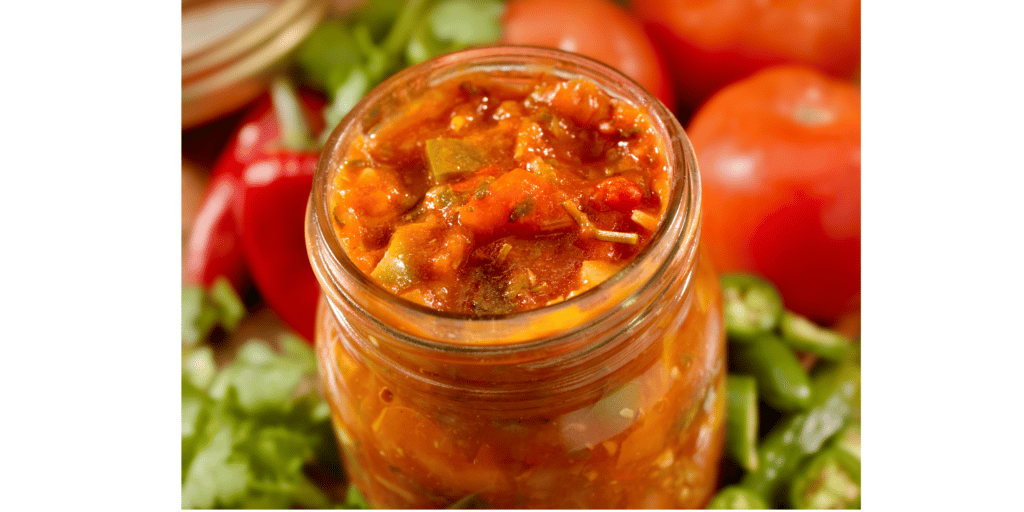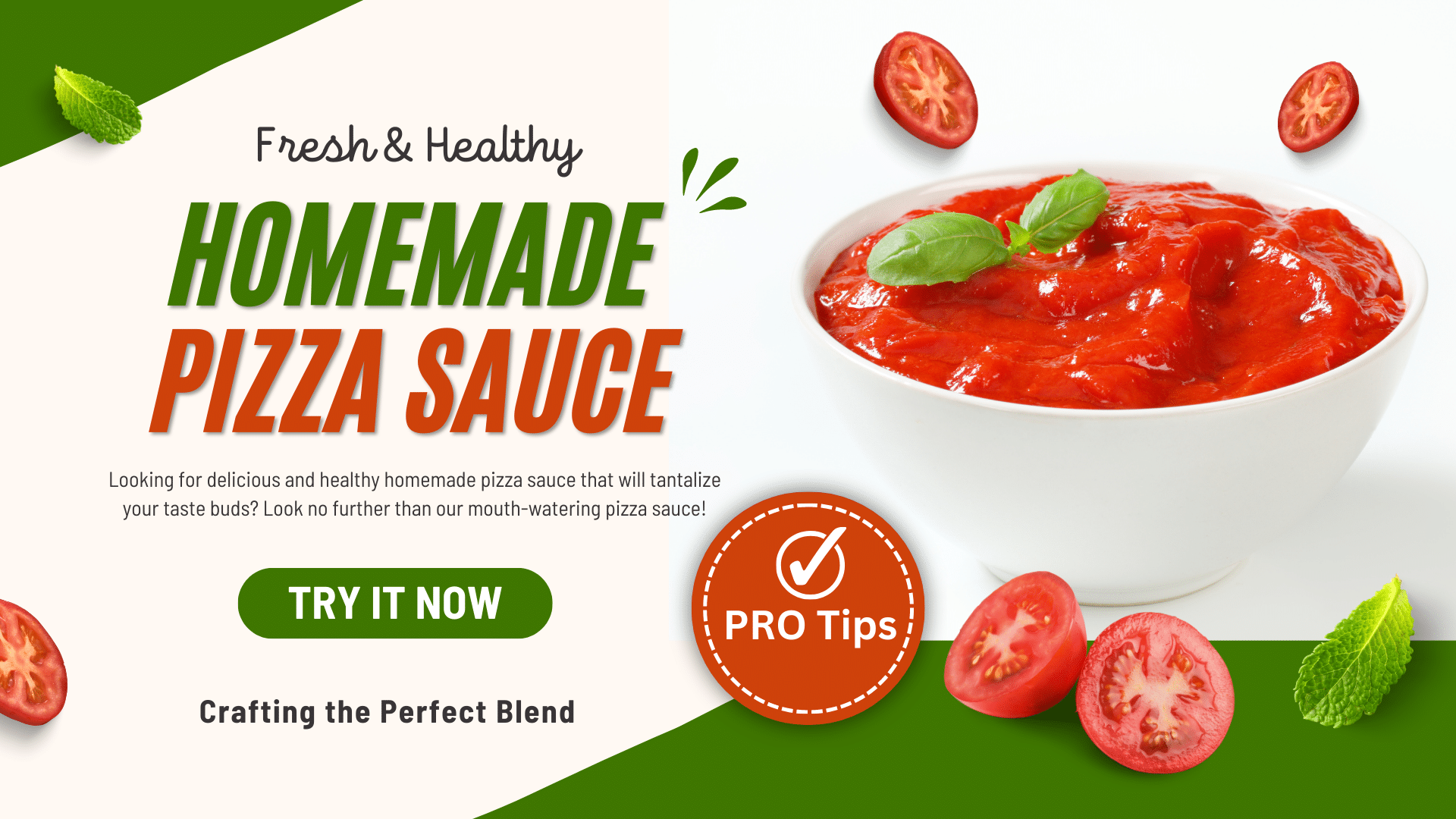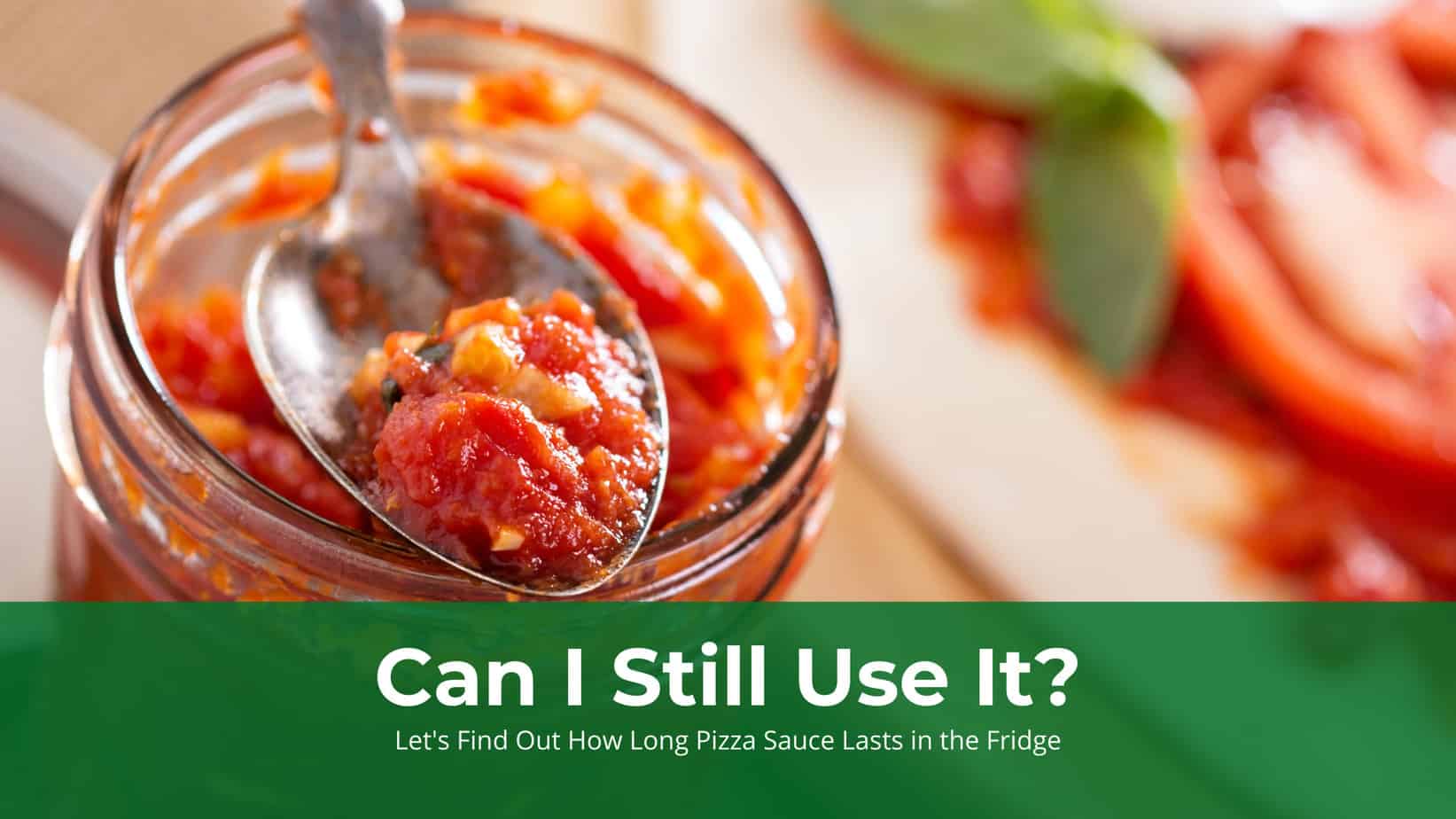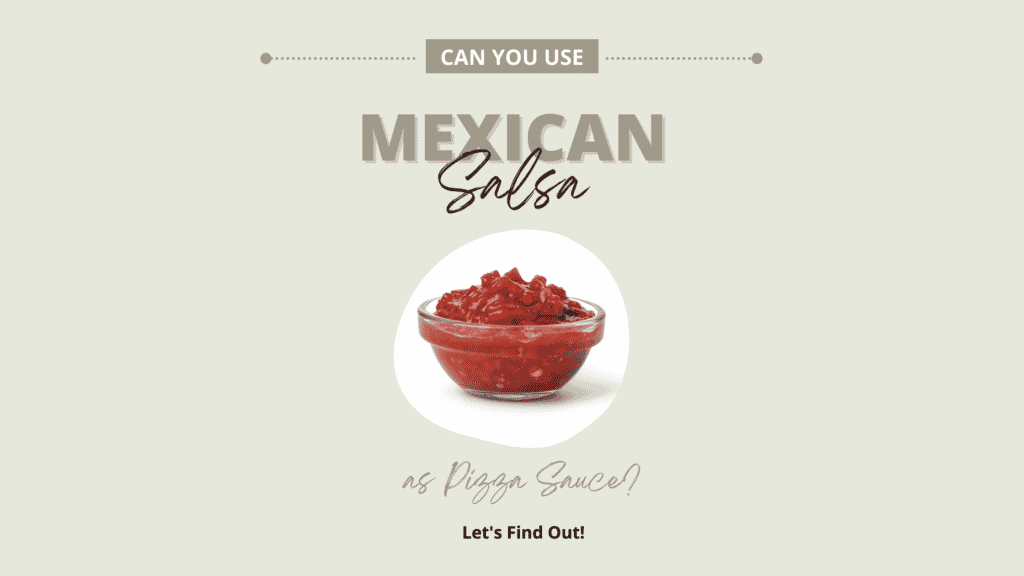Using Salsa as a Pizza Sauce
Are you wondering if you can use salsa as a pizza sauce?
Yes, you can use salsa as pizza sauce. Salsa is a great pizza sauce substitute. Read on to find out how to use salsa as a pizza sauce, tips on how to use salsa as a pizza sauce, how to make salsa and much more!
You might even want to make it your own and see what happens.
Let’s get started!
Here’s What You Will Find:
What is Salsa?
Salsa is a tomato-based spicy sauce and a great low-calorie substitute for pizza sauce.
Salsa sauce is a hot and tasty dipping sauce frequently used in Mexican food. Fresh tomatoes, onions, garlic, and various seasonings and spices are typically used to make it.
To improve the flavor and texture of the sauce, additional ingredients like cilantro, jalapenos, and lime juice may be used, depending on the recipe.

Salsa sauce gives every food a vivid and vibrant aspect, whether used as a dip or added to dishes like fajitas and enchiladas.
Salsa is made from corn oil, spices, and garlic powder and is an excellent alternative to pizza sauce. It can be made with chopped tomatoes, fresh herbs, or sugar.
Can You Use Salsa as Pizza Sauce?
Yes, salsa is a great substitute for pizza sauce, and you can make your own.
Even if some people might be skeptical about using different sauces on your pizza instead of the standard tomato sauce.

Thanks to the home-use pizza ovens, cooking professional-quality pizzas at home became a fad, and people began to get more inventive with their toppings and sauces.
As a result, various sauces, such as White Sauce, Hummus, Pesto, Marinara Sauce, Ranch Sauce, etc., have been created.
If you enjoy salsa, you should try using it as the sauce for a pizza. Salsa’s additional ingredients and spices will give your pizza a flavor boost.
So utilizing salsa as your sauce is a terrific choice if you want to liven up your regular pizza night.
Tips for Using Salsa as Pizza Sauce
To use salsa as a pizza sauce, you will thus need to carry out a few easy actions to “transform” your salsa into a suitable and delicious pizza sauce.
Drain the Salsa
To use salsa as pizza sauce, drain the salsa before using it as a sauce to prevent a soggy crust. Salsa is typically extremely chunky and watery, unlike pizza sauce. If you utilize it as-is, the pizza dough will absorb the liquid, resulting in a soggy crust.
To drain it, simply spoon it into a colander or sieve and let the extra liquid drain out.
Blend the Salsa
Using a food processor or an immersion blender, blend the salsa to make it thinner and spreadable.
Add Tomato Paste
Adding tomato paste to salsa is strongly advised if you use it as pizza sauce.
Salsa is a tomato-based dip; however, it doesn’t have as much tomato taste as pizza sauce.
You may create a sauce that mixes the robust taste of the salsa with the traditional flavor of pizza sauce by adding some tomato paste to the salsa.
Layer the Salsa on Top of the Cheese
As previously said, salsa differs somewhat from a conventional pizza sauce because it is chunky and watery. Having said that, you shouldn’t be prevented from using it on your pizzas.
Finding a method to keep the pizza dough from becoming sticky while still using the salsa as the pie’s basis is your objective here.
Applying the salsa over the cheese instead of straight onto the pizza base is an effective way to use salsa as a pizza sauce, as it prevents contact between the salsa and the pizza base.
The cheese will serve as a barrier to stop the sauce from soaking into the dough.
What Is The Difference Between Pizza Sauce and Salsa?
While sauces and salsas may add flavor to a dish, their applications and functions are distinct. The main variations between the two are as follows:
A sauce is typically a liquidy, smooth mixture that is added to food to improve the flavor. It can be thick or thin and is frequently made with a mixture of spices, herbs, and other ingredients.
On the other hand, salsa is a delicious, chunky concoction used as a dipping sauce or topping. It frequently has chili peppers or other seasonings added to it and generally has diced tomatoes, onions, peppers, and other vegetables. But as you can see, salsa is a great alternative to pizza sauce.
Benefits of Making Your Pizza Sauce
There are many benefits of making your pizza sauce.
Healthy
Salsa is a low-calorie alternative to pizza sauce, making it healthier.
Versatile
You can vary the ingredients and create your unique blend of flavors.
It pairs well with healthy toppings such as sausage, feta cheese, olives, or tomato. Alfredo isn’t healthy, but you can use salsa as pizza sauce. Other popular toppings include cubed chicken, spinach, tomatoes, and red pepper flakes.
Another great way to make pizza sauce is to drizzle EVOO on the crust. Use a robust EVOO for this purpose, as milder flavored oils aren’t suitable for pizza crust.
It’s a delicious, low-calorie alternative to pizza sauce. You can also add EVOO to salads to give them a delicious, crunchy crust.
Try it; you’ll be surprised at how well it works!
To make a low-calorie pizza, all you need is a good recipe. For the dough, start with seasoned Type 00 flour. This flour is a mix of flour, yeast, and salt.
You can also add low-calorie cheese or plain yogurt instead of mozzarella to cut the calories. The only downfall to plain yogurt is that it won’t have the same flavor as regular mozzarella cheese.
Instead of pizza crust, you can try vegetables, such as artichokes or cauliflower.
These vegetables are both high in antioxidants and low in fat. They can also be used to create a base for pizza. In addition, chunks of sweet potato add depth and flavor to your pizza.
Sweet potato can also be used to make a cauliflower crust. Another low-calorie alternative to pizza crust is a whole wheat bagel.
If you’d like to make your pizza, you can make it right in your skillet. The entire process only takes 20 minutes. It tastes better than a pizza you’ve purchased from a store.
You can use the yeast-free dough to make your pizza. This dough has a flaky crust and is high in protein. You can even top it with roasted squash and meaty mushrooms.
If you’re worried about the fat content of a traditional pizza, try a low-calorie alternative. These pizzas have fewer calories per slice and don’t sacrifice taste.
They’re also much more filling and have less cheese than regular pizzas. But be sure not to skip the cheese. They can’t be beaten! This is a delicious and healthy alternative to pizza sauce!
You can freeze the pizza sauce if you’re concerned about calories and carbs. You can make it in bulk and store it in the freezer for up to 4 to 6 months.
This way, you’ll always have a low-calorie alternative to pizza sauce. There are also other benefits to making your pizza sauce. It will save you a lot of time and money. You’ll be surprised at how convenient it is!
How is Salsa Made?
Salsa is made with corn oil, salt, spices, and garlic powder.
This fresh, spicy corn salsa uses garlic powder, onion, and spices to make a tasty dip. Its fresh flavor can’t be beaten. It also tastes great with tortilla chips or a salad.
A few simple ingredients give it a fresh, vibrant look. Consider adding a few avocados to the mix if you’re trying something new. If you’re adding black beans, a little extra may be all you need.
Fresh salsa outsold ketchup as America’s most popular condiment in 1991.
Today, salsa is the number one condiment sold in the United States.
Salsa is a versatile condiment that is widely available and popular for dipping chips. Its ingredients come from the New and Old World.
Some hottest ingredients are Mexican salsa, including tomato, chili, garlic, spices, and a touch of corn oil. Besides being delicious and healthy, salsa also tastes delicious. Its spicy heat will make any snack go down a treat.
While a basic recipe calls for just three main ingredients, many variations are available for this versatile condiment.
The classic version contains 1 cup of dried cilantro. A substitution for cilantro is parsley.
For more heat, you can add 1/8 cup chili powder. Red pepper flakes also add a little kick. Garlic powder and cumin give a more complex flavor and aroma to salsa.
This recipe is fast and easy to prepare. You’ll find the fresh kernels of corn cooked in lime juice and spices. Jalapeno peppers are a fun addition.
The corn salsa is easy to prepare, and kids will love helping you prep the ingredients. Make it in advance and serve to friends.
This healthy and tasty snack can be made ahead of time, and it’s sure to be a hit!
Mexican Salsa Pizza Sauce Recipe
Here is everything you need to make the most delicious salsa easily at home:
- 2 peeled tomatoes
- 1/2 cup red onion
- 2 garlic cloves
- 1 jalapeño
- Cilantro to taste
- 3 tsp fresh lime juice
- 1/4 tsp ground cumin
- Sugar to taste
- Salt to taste
- Canned crushed San Marzano tomatoes
- Diced green chiles (Mild or Spicy)
How To Make Salsa Pizza Sauce
- Add the vegetables to your food processor with lime juice and seasonings.
- Next, add the canned crushed San Marzano tomatoes, green chiles, and puree until almost smooth. The canned tomatoes provide a rustic essence and sweetness that accentuates the fresh produce, while the canned green chiles deliver a smoky quality that fresh peppers lack.
- Add more cumin and salt to taste, and refrigerate until chilled and ready to enjoy.
Salsa Ingredients Variants
To use salsa as pizza sauce, you can make salsa with fresh herbs, garlic cloves, red chili flakes, olive oil, and black pepper.
A blend of fresh herbs and spices, oregano is one of the most famous savory spices in the world. Its flavor is similar to that of pepper but has a pleasant minty aftertaste. It can be found in various foods, including pasta, salads, and lentil dishes. It’s also used as a condiment.
This blend is traditionally used to season poultry and other poultry, but it can be used for all types of cooking. It contains fresh herbs and spices such as dried sage, thyme, and rosemary.
It may also contain ground ginger, celery seed, and cloves. Using raw garlic is not recommended, as it may spoil the flavor. Add one or two minced garlic cloves if you like a more robust garlic flavor.
Before storing the jar, make sure the chili oil is cool. It can keep for up to 6 months.
Herbs can be purchased in supermarkets, often in about half-a-pound bundles. They can be purchased loosely in boxes or bunched together with a rubber band.
Some people grow their herbs or make flavor-infused oils at home. You can visit an Asian or Middle Eastern grocery store if you can’t grow your herbs. It may cost more than your local grocery store, but you’ll never know what’s in them!
Pepper is the most versatile spice in the kitchen and can be used to flavor almost any type of dish. When used correctly, it can enhance the taste and aroma of virtually any type of food. It’s a beautiful addition to any recipe, whether a main dish or a side dish.
Just remember to use plenty of pepper. There are many pepper sources worldwide, so don’t be afraid to experiment.
Cilantro is a blend of parsley and citrus. It has a similar taste to flat-leaved parsley, but the leaves are darker and have a mild, bitter taste.
Cilantro seeds are used as a spice and are often added at the end of cooking. It’s also used as a garnish in Asian and Chinese dishes.
For the most flavorful seasoning, choose an herb with a high spiciness.
For instance, fresh tarragon can add an intense fragrance to dishes and is used as a seasoning in Asian and European cuisine. If you prefer a softer herb, try chervil, which is native to the mountains of India.
There are some significant differences between regular pasta sauce and pizza sauce. For starters, pasta sauce contains more ingredients than pizza sauce.
Rather than chunky tomato slices, pasta sauce contains meat, onion slices, and even sausages.
In contrast, pizza sauce is not as high in ingredients but should be a delicious tomato base. Unlike pasta, the sauce on pizza is not the dish’s star.
The Last Slice
We hope you know if you can use salsa as pizza sauce. As you can see, nothing can stop you from making the most delicious pizza and innovating with a fusion of different cultures and flavors.
So carry on and keep making pizza like a PRO!
Additional Resources on Pizza Sauce

Homemade Pizza Sauce: Crafting the Perfect Blend
the PROs
You know that dreamy moment when you take a bite of pizza and the world just stops? When all the …

How Long Does Pizza Sauce Last In the Fridge? Here’s Everything You Need to Know
the PROs
End up making a large batch of delicious pizza sauce? Wondering how long does pizza sauce last in the fridge? We’ve got all your answers! Let’s check it out.

Can You Freeze Pizza Sauce? Here’s What You Need to Know
the PROs
So, it is evidently clear that you can store your pizza in the freezer. But how about the pizza sauce? Can you freeze pizza sauce as well in the freezer? In this piece, you will discover more about pizza sauce and how it can be stored in the freezer. Let’s dive in.
Enjoy!
Not a PRO? Not a Problem!
Take a pizza class to bring your pizza skills to the next level,
so you can be a PRO!
Related Posts

Costco Pizza Delivery: Find How You Can Get It Now!
the PROs
People go to Costco’s food court for many different reasons, but the cheesy slice of pizza they serve is among …

Pizza for Beginners: Don’t Buy Pizza, Make It! Here’s How to Get Started!
the PROs
You have this idea that you want to make pizza at home as opposed to ordering it, but where do you start? Don’t worry! Here you will find answers and directions to all your questions.

Pizza Toppings Under Cheese or Over Cheese? [Why the Order Matters]
the PROs
Is Pizza Cheese on Top or Bottom? Hey pizza lovers, are you wondering if you should layer pizza toppings under …
Newsletter
Subscribe to our Recipe of the Week newsletter and receive our partners’ latest recipes, tips, and discount offers.
Keep in Touch!

